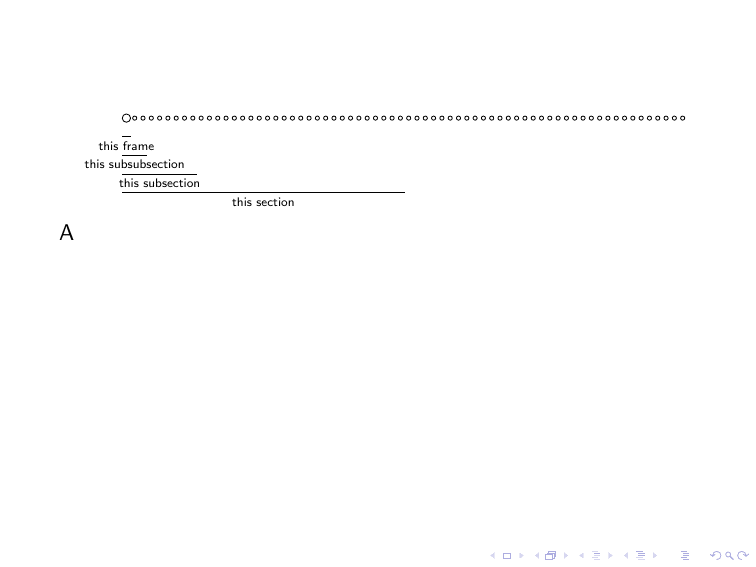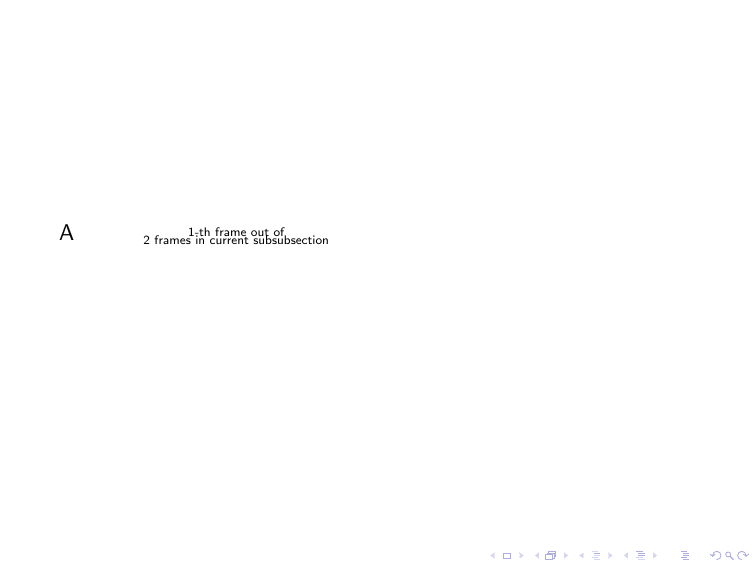
我想知道是否有一种简单的方法可以获取 Beamer 中的总帧数subsubsection?
我已经设法获得了每个帧的数量subsubsection,如在 MWE 中所见。
\documentclass{beamer}
\newcounter{insub}
\AtBeginSubsection[]{\setcounter{insub}{0}}
\AtBeginEnvironment{frame}{\addtocounter{insub}{1}}
\setbeamertemplate{frametitle}{\subsecname{} -- \theinsub\ of XYZ slides in current subsubsection}
\begin{document}
\section{A}
\subsection{A.1}
\subsection{First subsubsection}
\begin{frame}{.}
abc
\pause
cdef
\end{frame}
\begin{frame}{.}
How to automatically get XYZ?
\end{frame}
\subsection{Second subsubsection}
\begin{frame}{.}
abc
\pause
cdef
\end{frame}
\begin{frame}{.}
\end{frame}
\begin{frame}{.}
How to automatically get XYZ?
\end{frame}
\end{document}
答案1
这是一个概念证明
\documentclass{beamer}
\usepackage{tikz}
\begin{document}
\makeatletter
\newif\ifincurrentsection
\newif\ifincurrentsubsection
\newif\ifincurrentsubsubsection
\newif\ifincurrentframe
\def\counteverything{
\tikz[remember picture,overlay]{
\def\drawsubsubsection##1{
\ifx\subsubxpos\undefined\else
\draw(\subsubxpos-.5,-2)--node[below]{this subsubsection}(##1-.5,-2);
\global\let\subsubxpos\undefined
\fi
}
\def\headcommand##1{##1}
\def\beamer@documentpages##1{
\drawsubsubsection{##1+1}
}
\def\sectionentry##1##2##3##4##5{
\drawsubsubsection{##3}
}
\def\beamer@subsectionentry##1##2##3##4##5{
\drawsubsubsection{##4}
}
\def\beamer@subsubsectionentry##1##2##3##4##5##6{
\drawsubsubsection{##5}
\ifnum\c@section=##2
\incurrentsectiontrue
\else
\incurrentsectionfalse
\fi
\ifnum\c@subsection=##3
\incurrentsubsectiontrue
\else
\incurrentsubsectionfalse
\fi
\ifnum\c@subsubsection=##4
\incurrentsubsubsectiontrue
\else
\incurrentsubsubsectionfalse
\fi
\ifincurrentsection
\ifincurrentsubsection
\ifincurrentsubsubsection
\xdef\subsubxpos{##5}
\fi
\fi
\fi
}
\def\slideentry##1##2##3##4##5##6{
\ifnum\c@subsectionslide=##3
\incurrentframetrue
\else
\incurrentframefalse
\fi
}
\def\beamer@sectionpages##1##2{
\ifincurrentsection
\draw(##1-.5,-4)--node[below]{this section}(##2+.5,-4);
\fi
}
\def\beamer@subsectionpages##1##2{
\ifincurrentsection
\ifincurrentsubsection
\ifnum##1<##2
\draw(##1-.5,-3)--node[below]{this subsection}(##2+.5,-3);
\fi
\fi
\fi
}
\def\beamer@framepages##1##2{
\draw foreach\x in{##1,...,##2}{
\ifnum\c@page=\x
(\x,0)circle(2pt)
\else
(\x,0)circle(1pt)
\fi
};
\ifincurrentsection
\ifincurrentsubsection
\ifincurrentsubsubsection
\ifincurrentframe
\draw(##1-.5,-1)--node[below]{this frame}(##2+.5,-1);
\fi
\fi
\fi
\fi
}
\tikzset{shift={(2,-2)},x=4pt,y=9pt}
\input{\jobname.nav}
}
}
\setbeamertemplate{headline}{
\counteverything
}
\section{Sec1}
\subsection{Sec1-Ssec1}
\subsubsection{Sec1-Ssec1-sssec1}
\frame{A}
\frame{B\pause C}
\subsubsection{Sec1-Ssec1-sssec2}
\frame{A}
\frame{B\pause C}
\frame{D\pause E\pause F}
\subsection{Sec1-Ssec2}
\subsubsection{Sec1-Ssec2-sssec1}
\frame{A}
\frame{B\pause C}
\frame{D\pause E\pause F}
\frame{G\pause H\pause I\pause J}
\subsubsection{Sec1-Ssec2-sssec2}
\frame{A}
\frame{B\pause C}
\frame{D\pause E\pause F}
\frame{G\pause H\pause I\pause J}
\frame{K\pause L\pause M\pause N\pause O}
\section{Sec2}
\subsection{Sec2-Ssec1}
\subsubsection{Sec2-Ssec1-sssec1}
\frame{A}
\frame{B\pause C}
\subsubsection{Sec2-Ssec1-sssec2}
\frame{A}
\frame{B\pause C}
\frame{D\pause E\pause F}
\subsection{Sec1-Ssec2}
\subsubsection{Sec2-Ssec2-sssec1}
\frame{A}
\frame{B\pause C}
\frame{D\pause E\pause F}
\frame{G\pause H\pause I\pause J}
\subsubsection{Sec2-Ssec2-sssec2}
\frame{A}
\frame{B\pause C}
\frame{D\pause E\pause F}
\frame{G\pause H\pause I\pause J}
\frame{K\pause L\pause M\pause N\pause O}
\end{document}
编辑
这就是 OP 想要的。这个想法是使用诸如此类的钩子\slideentry来帮助你积累。
\documentclass{beamer}
\usepackage{tikz}
\begin{document}
\makeatletter
\newif\ifincurrentsection
\newif\ifincurrentsubsection
\newif\ifincurrentsubsubsection
\newif\ifincurrentframe
\def\counteverything{
\tikz[remember picture,overlay]{
\def\stopcountingsubsubsection{
\ifx\subsubcount\undefined\else
\draw(2,-2)node[align=center]{
\subsubindex-th frame out of \\
\subsubcount\ frames in current subsubsection
};
\global\let\subsubcount\undefined
\fi
}
\def\headcommand##1{##1}
\def\beamer@documentpages##1{
\stopcountingsubsubsection
}
\def\sectionentry##1##2##3##4##5{
\stopcountingsubsubsection
}
\def\beamer@subsectionentry##1##2##3##4##5{
\stopcountingsubsubsection
}
\def\beamer@subsubsectionentry##1##2##3##4##5##6{
\stopcountingsubsubsection
\ifnum\c@section=##2
\incurrentsectiontrue
\else
\incurrentsectionfalse
\fi
\ifnum\c@subsection=##3
\incurrentsubsectiontrue
\else
\incurrentsubsectionfalse
\fi
\ifnum\c@subsubsection=##4
\incurrentsubsubsectiontrue
\else
\incurrentsubsubsectionfalse
\fi
\ifincurrentsection
\ifincurrentsubsection
\ifincurrentsubsubsection
\xdef\subsubcount{0}
\fi
\fi
\fi
}
\def\slideentry##1##2##3##4##5##6{
\ifnum\c@subsectionslide=##3
\incurrentframetrue
\else
\incurrentframefalse
\fi
}
\def\beamer@sectionpages##1##2{}
\def\beamer@subsectionpages##1##2{}
\def\beamer@framepages##1##2{
\ifincurrentsection
\ifincurrentsubsection
\ifincurrentsubsubsection
\pgfmathtruncatemacro\subsubcount{\subsubcount+1}
\ifincurrentframe
\xdef\subsubindex{\subsubcount}
\fi
\fi
\fi
\fi
}
\tikzset{shift={(2,-2)}}
\input{\jobname.nav}
}
}
\setbeamertemplate{headline}{
\counteverything
}
\section{Sec1}
\subsection{Sec1-Ssec1}
\subsubsection{Sec1-Ssec1-sssec1}
\frame{A}
\frame{B\pause C}
\subsubsection{Sec1-Ssec1-sssec2}
\frame{A}
\frame{B\pause C}
\frame{D\pause E\pause F}
\subsection{Sec1-Ssec2}
\subsubsection{Sec1-Ssec2-sssec1}
\frame{A}
\frame{B\pause C}
\frame{D\pause E\pause F}
\frame{G\pause H\pause I\pause J}
\subsubsection{Sec1-Ssec2-sssec2}
\frame{A}
\frame{B\pause C}
\frame{D\pause E\pause F}
\frame{G\pause H\pause I\pause J}
\frame{K\pause L\pause M\pause N\pause O}
\section{Sec2}
\subsection{Sec2-Ssec1}
\subsubsection{Sec2-Ssec1-sssec1}
\frame{A}
\frame{B\pause C}
\subsubsection{Sec2-Ssec1-sssec2}
\frame{A}
\frame{B\pause C}
\frame{D\pause E\pause F}
\subsection{Sec1-Ssec2}
\subsubsection{Sec2-Ssec2-sssec1}
\frame{A}
\frame{B\pause C}
\frame{D\pause E\pause F}
\frame{G\pause H\pause I\pause J}
\subsubsection{Sec2-Ssec2-sssec2}
\frame{A}
\frame{B\pause C}
\frame{D\pause E\pause F}
\frame{G\pause H\pause I\pause J}
\frame{K\pause L\pause M\pause N\pause O}
\end{document}




